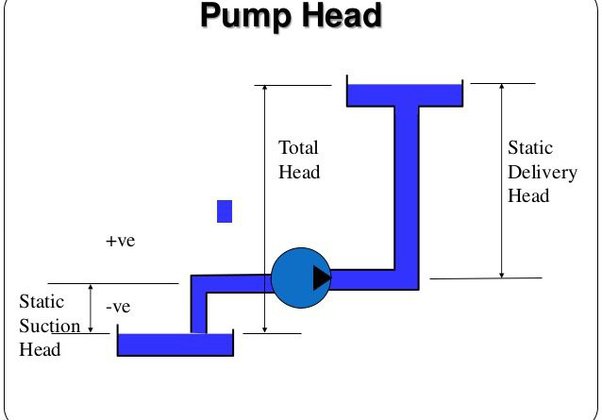Water pumps are in use all around us. They can pump water from a well into our home or circulate the water in our central heating system and perform many other fluid moving tasks. One of the most misunderstood physical characteristics of a pump is the concept of the head. It’s a concept that is incredibly simple to define but can be confusing when the concept is translated into examples involving real pumps.
The highest height at which a pump can convey fluid against gravity is called the head. If you have a vertical pipe running straight up from the discharge exit, this is the clearest example. Fluid will be pumped up the pipe 5 meters from the discharge exit by a pump with a 5-meter head. A pump is an important Product of employing Industrial Tools. Pumps are provided by several Suppliers and Companies, different manufacturers, and a lot of distributors and there are a lot of pumps for sale on Linquip.
A full list of pump head services is available on the Linquip website, which covers all OEM fleets. Linquip vendors can assist you with this. Please contact Linquip’s Pump Experts to learn more about how to connect with a wide choice of Service Providers who consistently deliver the highest quality products.
This article will define the term “head” as it relates to pumps, so you should never have to worry again about what is head of a pump? or why it’s important. Follow this new bog in Linquip to find out.
⇒ View a List of Pump for Sale and Their Suppliers ⇐
what is head of a pump?
The pump head or discharge head of a water pump is a measure of the power of a pump. The greater the pump head, the greater the pressure that the pump can generate. This statistic is measured in meters (or feet) and is calculated by placing a tube on a pump’s discharge and measuring the maximum height to which it can pump water.

Simply stated, a pump’s head is the maximum height that the pump can achieve pumping against gravity. Intuitively, if a pump can produce more pressure, it can pump water higher and produce a higher head. The purest example of this is if you have a vertical pipe extending straight up from the discharge outlet. A pump with 5m of the head will pump fluid up the pipe 5m from the discharge outlet.
Also note that the higher the liquid in the tank, the higher the pump will be able to pump the water into the vertical discharge pipe, due to the head exerted by the liquid in the suction tank.
The imaginary vertical discharge pipe used to measure the head is shown in the figure below.
Pressure vs Head
Sometimes the head can be confused with pressure during pump choice. There is a strict relation between them which is defined by the fluid specific gravity, so the relation is fluid dependent. So what is the difference between pressure and head?
As mentioned above, Head is the height given by the pump to the fluid and it is measured in meters of liquid column [m.l.c.] or simply indicated in meters [m]. The given head is fluid independent, meaning different fluids with different specific gravities are all lifted at the same height. Pressure, instead, is fluid dependent and is affected by the liquid density. The force of a fixed height liquid column over a unitary area will change with different specific gravities. So in this case the same head generates different pressures.
The pump head calculation is not done directly. Manometers on the pump suction and delivery line give the measure of the pressure. Measurements given by manometers indicate differential pressures imposed by the pump between suction and discharge. These measures are read in [bar] [atm] [psi] [ft H2O] etc. Specific gravity γ has to be considered to evaluate the correspondent head.
Total head
A much more useful measure of the head is the difference between the liquid level in the suction tank and the head in the vertical discharge pipe. This number is known as the “total head” that the pump can produce.

Increasing the level of the liquid in the suction tank will give rise to the increased head, and decreasing the level will give rise to a lower head. Pump manufacturers and suppliers often won’t tell you how much head a pump can produce, because they can’t predict what the height of the liquid in your suction tank will be. Instead, they will report the total head of pump, the difference in height between the level of liquid in the suction tank, and the height of a column of water that the pump can achieve. The total head is independent of the level of liquid in the suction tank.
Mathematically speaking, the total head formula is as follows.
Total Head = Pump Head – Suction Head.
Pump Head vs. Suction Head
A pump’s suction head is similar to its pump head except it is the opposite. Rather than being a measure of the maximum discharge, it is a measure of the maximum depth from which a pump can raise water via suction.
These are two equal but opposite forces that affect the flow of water pumps. As mentioned above, Total Head = Pump Head – Suction Head.
If the water level is higher than the pump, then the suction head is negative and the pump head will increase. This is because the water entering the pump applies additional pressure at the suction.
Conversely, if the pump is located above the water to be pumped, then the suction head is positive and the pump head will decrease. This is because the pump must use energy to bring the water to the level of the pump.
Pump head vs Flow rate
At the maximum pump head, the flow of a water pump system is zero. This is because the pump cannot generate any pressure to move water since all of the power is being used to lift the water that is already in the system.
When the pump head is zero, the water flows at the maximum rate. The result of zero pump head is that the pump’s energy can be entirely applied to moving water, rather than lifting it, so flow is faster.
As pump head increases, flow decreases, and vice versa. This relationship creates a unique graph of an individual pump’s operating field that can be used to select the correct water pump for any job.
Of course, when the flow is introduced into a pump system, friction must be taken into account. The force of friction between the water and the sides of the pipe further reduces the flow rate.
When considering a flowing water pump system, Total Head = (Pump Head – Suction Head) + Friction. We are not going to discuss pipe friction here in any detail but it is important to know that if you are going to pump across a long-distance as well as up you are going to affect the overall pump head. The roughness of the pipe surface and sharp bends in the pipework will have significant effects on the pump head.
So, now that you know the answer to the question ‘what is head of a pump?’, let us know what you think by leaving a reply in the comment section. We will be glad to have your viewpoint on the article. Is there any question we can help you through? Feel free to sign up on Linquip to get the most professional advice from our experts.
Download what is head of a pump PDF
Buy Equipment or Ask for a Service
By using Linquip RFQ Service, you can expect to receive quotations from various suppliers across multiple industries and regions.
Click Here to Request a Quotation From Suppliers and Service Providers
Read More on Linquip
- What is Hydraulic Pump: Learn The Basics, Boost Your Knowledge
- Difference Between Pump and Turbine
- How Does a Hydraulic Pump Work? A Definitive Guide
- Pump Curve: All You Should Know About Definition and Read One
- Types of Pump Casings (In Centrifugal Pumps & Others) + Pros & Cons
- What Is a Demand Pump and How Does It Work? (Clear Guide)
- The 10 Best Condensate Pumps of 2022: A Complete Guide
- 13 Parts of Concrete Pump with Name & PDF
- 8 main Parts of Piston Pump and Function + Work & PDF
- Types of Fire Hydrant Systems
- Parts of Water Pump
- Working Principles of Hydraulic Pump (With Videos)
- What is Sump Pump and How Does It Work?
- What Is a Multistage Centrifugal Pump Used for?
- What is Head of a Pump? A Complete Guide
- How and When to Replace Your Sump Pump?
- What Is a Demand Pump and How Does It Work?





Your article is of the greatest conciseness and clarity. Really helpful!
Dear Cesare
Thanks for your attention.
Help full content ..?
Thanks for visiting our website and leaving your comment, Javed! We hope to hear from you again in our other posts.
A very brief & comprehensive description on suction and discharge Head. Very easily understandable & conceptual. Best regards. Engr. M. Aslam
Thanks for sharing your experience with us! You can also visit our industrial directories, where you can find thousands of various industrial equipment based on your application and demand.
Really helpful
I would like to have this information in my phone if it could have been in pdf
Any information on how to calculate the friction loss in a pipe, the two Darcy equations?
Great read. Thanks for putting this together.
Your kind words are much appreciated, Gavin! It was a pleasure having you visit us.
Very helpful, thank you!
Thanks for sharing your experience with us, Robert! You can also visit our industrial directories, where you can find thousands of various industrial equipment based on your application and demand.
Hello, I am trying to use a 3hp submersible well pump that is suspended on float’s in my lake as a fountain
The flow of water is not what it should be, considering its at zero pump head. Is there something I am doing wrong .
Thank you for any help!!
We appreciate you taking the time to check out our page. Asking one of our specialists will help you get your problem fixed.